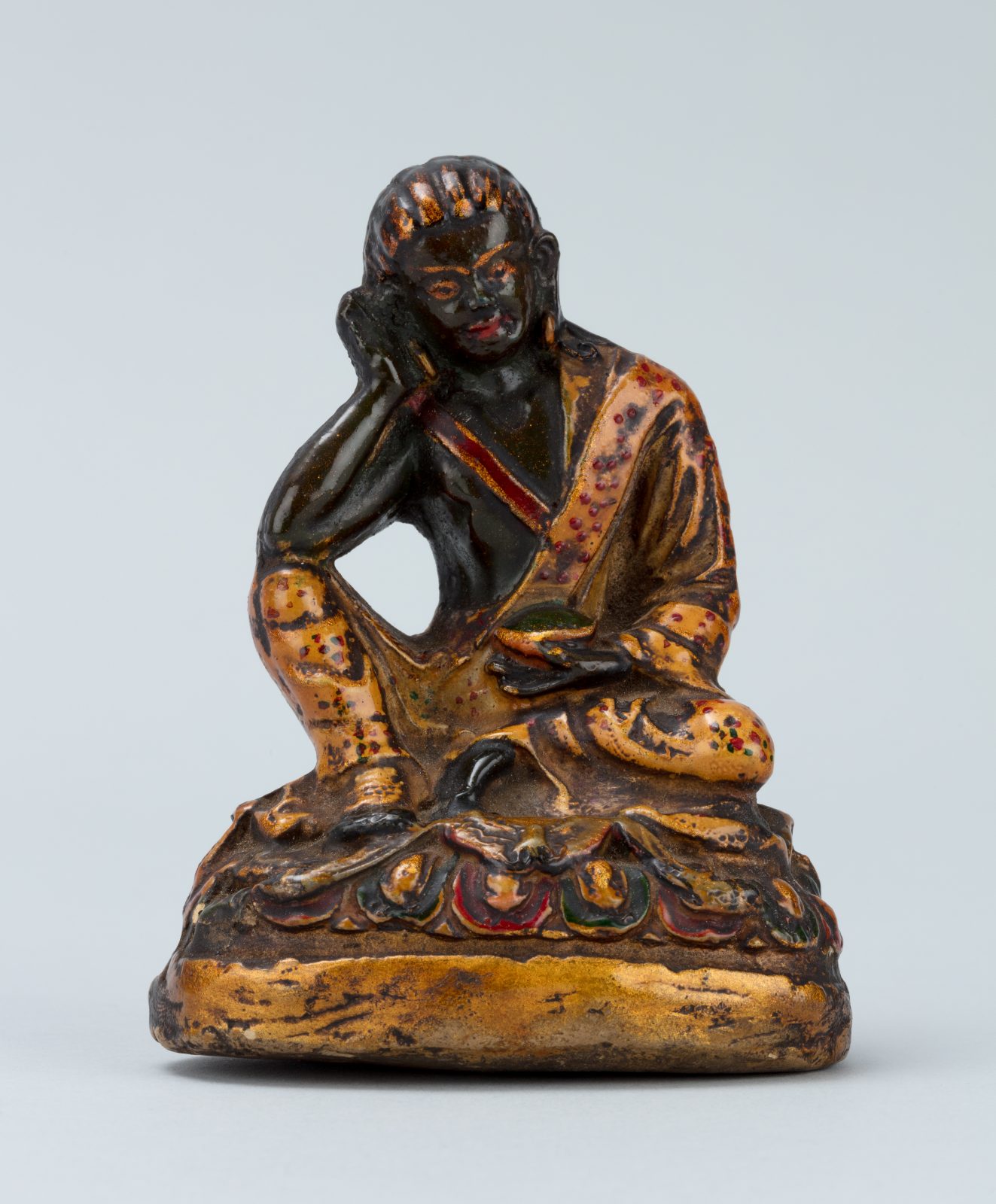
Lama (Teacher), Milarepa; Tibet; 18th century; Stone; Rubin Museum of Himalayan Art, gift of the Shelley and Donald Rubin Foundation; F1997.52.4

Lama (Teacher), Milarepa; Tibet; 18th century; Stone; Rubin Museum of Himalayan Art, gift of the Shelley and Donald Rubin Foundation; F1997.52.4
For many people, the Buddhist concept of non-attachment might initially seem perplexing, or even off-putting. The English term “non-attachment” can give the misleading impression that we should not enjoy anything, or worse, that we are supposed to cultivate indifference or disconnection. But for Buddhists, non-attachment actually conveys the opposite: a transformative reorientation of ourselves and our relationships, an opening up to love and compassion without limit. Indeed, according to Buddhist thinkers past and present, without understanding and practicing non-attachment, we are unable to experience the true enjoyment and connection that we long for. Ultimately, non-attachment in the Buddhist sense reveals the joyful freedom of knowing reality as it really is.
To understand why Buddhists describe non-attachment as an essential and liberating practice, it can be helpful to start with non-attachment’s inverse: the ordinary, addictive way we habitually go about our lives. Think about the moment you wake up each day: Do you stretch? Wish for more sleep? Gulp coffee or tea? Maybe you think about what you’ll do at work or how you hope to see this person, avoid that one, receive a compliment, avoid criticism. Whatever our daily routine, we all have the habit of reaching for experiences we like and pushing away those that we don’t. We are continually hoping for more of this, less of that, in a constant stream of mental activity that a famous Chan Buddhist text calls “picking and choosing.”
Buddhist writers and teachers across the centuries have had a lot to say about the inner process of this picking and choosing. According to Buddhist sources, we ordinarily operate in the endless grip of attachment, understood as a core aspect of how we—and all living beings—relate to our lives. (The English word “attachment” can translate a range of Buddhist terms related to grasping, craving, and desire, such as taṇhā, lobha, and rāga in Sanskrit and Pāli, and chags pa, ’dod chags, and ’dod pa in Tibetan.) Buddhist writers point out that we often think if we could just arrange circumstances to our liking, we would be happy, safe, and problem-free. But the push-pull of our grasping mind continually fails to deliver. Indeed, the relentless grind of attachment and its inseparable twin, aversion, are fundamental aspects of what the Buddha Shakyamuni described as dukkha, the suffering or “dis-ease” that pervades all our ordinary perceptions and experiences.
The nineteenth-century eastern Tibetan Buddhist master Dza Paltrul Rinpoche famously compared our attachment-oriented pursuit of pleasure to licking honey off a knife. We taste sweet honey, but at the exact same moment, the blade slices our tongue. Although we think our attachments will bring us what we want, our attachment contaminates every pleasure with a wound. And the problems with attachment don’t stop with how we hurt or disappoint ourselves. Buddhist teachers say that attachment distorts all our relationships, ironically leading us to subtly center ourselves even when we most wish to be present with others. Attachment gives rise to poisonous emotions like greed, hatred, and jealousy, and compromises our availability for ethical and loving relationships.
As described by Buddhist teachers like Paltrul Rinpoche, our attachment to our own preferences and storylines ultimately reveals a still-deeper form of grasping—the clutching at self-identity that fuels all our suffering. This subtle attachment to self-identity is tied to our ignorance, or more accurately, our miscognition of reality, the miscognition that Buddhists identify as the root “poison” standing between us and enlightenment. Our miscognition is to think we exist as a separate and unchanging self, and then we grab tightly onto the private, isolated self that we think we are. Yet in actuality, as Buddhist thinkers like Paltrul explain, this presumed egocentric self is not how we exist at all. In reality, we are interdependent with all things in an infinitely dynamic relational web of mutual connection and transformation.
At the most basic level then, Buddhist ideas and practices of non-attachment are about freeing ourselves from the grasping states of mind that reduce all relations and events to the ego, trapping us in the closed circle of me and mine, and binding us in a deluded relation to the world. All Buddhist practices of non-attachment turn out to be on some level about making a shift in our awareness: giving ourselves the gift of freedom from our stories about ourselves.
Buddhist techniques for cultivating non-attachment include many methods for working with the body, with social life and relationships, and with the mind and emotions in meditation, ritual, and devotional practice. Bodily and social techniques for developing non-attachment can include a range of renunciant lifestyles and many kinds of vows, including the five vows of lay practitioners and the more detailed vows of monks and nuns. Many traditional ways of teaching and practicing non-attachment begin with material and bodily forms of renunciation and build on these as a foundation for developing a deeper non-attachment to underlying conceptions of self.
The beloved Tibetan saint Milarepa exemplifies multiple layers of cultivating non-attachment, from his practicing renunciation in mountain caves and relinquishing conventional social status to his meditations on the true nature of mind and reality. There are many more recent examples as well, like the twentieth-century Himalayan renunciant and scholar Khunu Lama Tenzin Gyaltsen, whose writings on non-attachment and bodhicitta are often taught by His Holiness the Dalai Lama, and Yongey Mingyur Rinpoche, who has written about cultivating non-attachment during his four-and-a-half-year wandering, homeless retreat.
The practice of non-attachment can take many forms, sometimes intensively communal, sometimes more solitary. Certain Buddhist sources emphasize the value of structured group practices of non-attachment in keeping people honest, preventing individual meditators from becoming isolated or deluding themselves about the progress they’ve made. Yet other Buddhist sources advise practitioners to give up attachment even to monastic robes, institutional roles, or the very idea of being a “Buddhist,” because all of these can involve grasping at a certain story of the self. Ultimately, Buddhist teachers emphasize that an inner attitude of non-attachment is what truly matters, both for achieving liberation from the egocentric self and for compassionately relieving the suffering of others.

Annabella Pitkin is associate professor of Buddhism and East Asian religions at Lehigh University. Her research focuses on Tibetan Buddhist modernity, Buddhist ideals of renunciation, miracle narratives, and Buddhist biographies. She received her BA from Harvard University and PhD in religion from Columbia University. She is the author of Renunciation and Longing: The Life of a Twentieth-Century Himalayan Buddhist Saint, which explores themes of non-attachment and teacher-student relationship in the life of Khunu Lama Tenzin Gyaltsen. More →
Get the latest news and stories from the Rubin, plus occasional information on how to support our work.